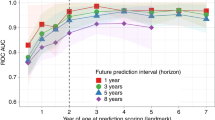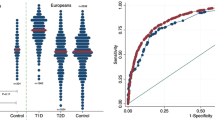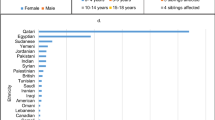Abstract
Genome-wide association studies have identified gene regions associated with type 1 diabetes. The aim of this study was to determine how the combined allele frequency of multiple susceptibility genes can stratify islet autoimmunity and/or type 1 diabetes risk. Children of parents with type 1 diabetes and prospectively followed from birth for the development of islet autoantibodies and diabetes were genotyped for single-nucleotide polymorphisms at 12 type 1 diabetes susceptibility genes (ERBB3, PTPN2, IFIH1, PTPN22, KIAA0350, CD25, CTLA4, SH2B3, IL2, IL18RAP, IL10 and COBL). Non-human leukocyte antigen (HLA) risk score was defined by the total number of risk alleles at these genes. Receiver operator curve analysis showed that the non-HLA gene combinations were highly effective in discriminating diabetes and most effective in children with a high-risk HLA genotype. The greatest diabetes discrimination was obtained by the sum of risk alleles for eight genes (IFIH1, CTLA4, PTPN22, IL18RAP, SH2B3, KIAA0350, COBL and ERBB3) in the HLA-risk children. Non-HLA-risk allele scores stratified risk for developing islet autoantibodies and diabetes, and progression from islet autoimmunity to diabetes. Genotyping at multiple susceptibility loci in children from affected families can identify neonates with sufficient genetic risk of type 1 diabetes to be considered for early intervention.
This is a preview of subscription content, access via your institution
Access options
Subscribe to this journal
Receive 6 digital issues and online access to articles
$119.00 per year
only $19.83 per issue
Buy this article
- Purchase on Springer Link
- Instant access to full article PDF
Prices may be subject to local taxes which are calculated during checkout





Similar content being viewed by others
References
Todd JA, Walker NM, Cooper JD, Smyth DJ, Downes K, Plagnol V et al. Robust associations of four new chromosome regions from genome-wide analyses of type 1 diabetes. Nat Genet 2007; 39: 857–864.
Barrett JC, Clayton DG, Concannon P, Akolkar B, Cooper JD, Erlich HA et al. Genome-wide association study and meta-analysis find that over 40 loci affect risk of type 1 diabetes. Genome-wide association study and meta-analysis find that over 40 loci affect risk of type 1 diabetes. Nat Genet 2009; 41: 703–707.
Noble JA, Valdes AM, Cook M, Klitz W, Thomson G, Erlich HA . The role of HLA class II genes in insulin-dependent diabetes mellitus: molecular analysis of 180 Caucasian, multiplex families. Am J Hum Genet 1996; 59: 1134–1148.
Todd JA . Etiology of type 1 diabetes. Immunity 2010; 32: 457–467.
Tait BD, Colman PG, Morahan G, Marchinovska L, Dore E, Gellert S et al. HLA genes associated with autoimmunity and progression to disease in type 1 diabetes. Tissue Antigen 2003; 61: 146–153.
Winkler C, Lauber C, Adler K, Grallert H, Illig T, Ziegler AG et al. An interferon-induced helicase (IFIH1) gene polymorphism associates with different rates of progression from autoimmunity to type 1 diabetes. Diabetes 2011; 60: 685–690.
Douroudis K, Laine AP, Heinonen M, Hermann R, Lipponen K, Veijola R et al. Association of CTLA4 but not ICOS polymorphisms with type 1 diabetes in two populations with different disease rates. Hum Immunol 2009; 70: 536–539.
Lempainen J, Hermann R, Veijola R, Simell O, Knip M, Ilonen J . Effect of the PTPN22 and INS risk genotypes on the progression to Clinical Type 1 Diabetes After the Initiation of β-cell autoimmunity. Diabetes 2012; 61: 963–966.
Steck AK, Wong R, Wangner B, Johanson K, Liu E, Romanos J et al. Effects of non-HLA gene polymorphisms on development of islet autoimmunity and type 1 diabetes in a population with high-risk HLA-DR,DQ genotypes. Diabetes 2012; 61: 753–758.
Lluís-Ganella C, Lucas G, Subirana I, Sentí M, Jimenez-Conde J, Marrugat J et al. Additive effect of multiple genetic variants on the risk of coronary artery disease. Rev Esp Cardiol 2010; 63: 925–933.
Walter M, Albert E, Conrad M, Keller E, Hummel M, Ferber K et al. IDDM2/insulin VNTR modifies risk conferred by IDDM1/HLA for development of Type 1 diabetes and associated autoimmunity. Diabetologia 2003; 46: 712–720.
Skyler JS . Type 1 Diabetes TrialNet Study Group; update on worldwide efforts to prevent type 1 diabetes. Ann NY Acad Sci 2008; 1150: 190–196.
Ziegler AG, Hummel M, Schenker M, Bonifacio E . Autoantibody appearance and risk for development of childhood diabetes in offspring of parents with type 1 diabetes: the 2-year analysis of the German BABYDIAB Study. Diabetes 1999; 48: 460–468.
Puavilai G, Chanprasertyotin S, Sriphrapradaeng A . Diagnostic criteria for diabetes mellitus and other categories of glucose intolerance: 1997 criteria by the Expert Committee on the Diagnosis and Classification of Diabetes Mellitus (ADA), 1998 WHO consultation criteria, and 1985 WHO criteria. World Health Organization. Diabetes Res Clin Pract 1999; 44: 21–26.
Achenbach P, Lampasona V, Landherr U, Koczwara K, Krause S, Grallert H et al. Autoantibodies to zinc transporter 8 and SLC30A8 genotype stratify type 1 diabetes risk. Diabetologia 2009; 52: 1881–1888.
Törn C, Mueller PW, Schlosser M, Bonifacio E, Bingley PJ . Participating laboratories. diabetes antibody standardization program: evaluation of assays for autoantibodies to glutamic acid decarboxylase and islet antigen-2. Diabetologia 2008; 51: 846–852.
Schlosser M, Mueller PW, Törn C, Bonifacio E, Bingley PJ . Participating laboratories. diabetes antibody standardization program: evaluation of assays for insulin autoantibodies. Diabetologia 2010; 53: 2611–2620.
Schenker M, Hummel M, Ferber K, Walter M, Keller E, Albert ED et al. Early expression and high prevalence of islet autoantibodies for dr3/4 heterozygous and dr4/4 homozygous offspring of parents with type i diabetes: the german babydiab study. Diabetologia 1999; 42: 671–677.
TEDDY Study Group 2007. The Environmental Determinants of Diabetes in the Young (TEDDY) study: study design. Pediatr Diabetes 2007; 8: 286–298.
Elks CE, Loos RJ, Sharp SJ, Langenberg C, Ring SM, Timpson NJ et al. Genetic markers of adult obesity risk are associated with greater early infancy weight gain and growth. PLoS Med 2010; 7: e1000284.
Fawcett T . An introduction to ROC analysis. Pattern Recognition Lett 2006; 27: 861–874.
Clayton DG . Prediction and interaction in complex disease genetics: experience in type 1 diabetes. PLoS Genet 2009; 5: e1000540.
Acknowledgements
We thank Annette Knopff, Stephanie Krause, Claudia Matzke, Marlon Scholz, Daniela Höfelmann, Jesse Hansen, Joanna Stock, Claudia Ramminger, Julia Schenkel, Nadine Bruckmeier, Nadja Kocher, Melanie Herbst and Ina Geisler for data collection and expert technical assistance, and Ramona Puff for laboratory management. We also thank all pediatricians and family doctors in Germany for participating in the BABYDIAB study. The work was supported by grants from the Kompetenznetz Diabetes mellitus (Competence Network for Diabetes mellitus) funded by the Federal Ministry of Education and Research (FKZ 01GI0805-07), the European Union (EP7-HEALTH-2007, DIAPREPP N202013) and the Juvenile Diabetes Research Fund (No 17-2012-16). EB is supported by the DFG Research Center and Cluster of Excellence—Center for Regenerative Therapies Dresden (FZ 111). JL is supported by the Finnish Foundation for Pediatric Research and Turku University Hospital Foundation. This study was supported in part by a grant from the German Federal Ministry of Education and Research (BMBF) to the German Center for Diabetes Research (DZD e.V.).
Author information
Authors and Affiliations
Corresponding authors
Ethics declarations
Competing interests
The authors declare no conflict of interest.
Additional information
Supplementary Information accompanies the paper on Genes and Immunity website
Supplementary information
Rights and permissions
About this article
Cite this article
Winkler, C., Krumsiek, J., Lempainen, J. et al. A strategy for combining minor genetic susceptibility genes to improve prediction of disease in type 1 diabetes. Genes Immun 13, 549–555 (2012). https://doi.org/10.1038/gene.2012.36
Received:
Revised:
Accepted:
Published:
Issue Date:
DOI: https://doi.org/10.1038/gene.2012.36
Keywords
This article is cited by
-
The countdown to type 1 diabetes: when, how and why does the clock start?
Diabetologia (2023)
-
Utility of genetic risk scores in type 1 diabetes
Diabetologia (2023)
-
An intelligent cloud robotics personalized medicine system by assessment of DNA and electronic health records using fuzzy-based progressive alignment sequence (F-Pas)
Soft Computing (2023)
-
Genetic variation at ERBB3/IKZF4 and sexual dimorphism in epitope spreading in single autoantibody-positive relatives
Diabetologia (2021)
-
Type 1 diabetes genetic risk score is discriminative of diabetes in non-Europeans: evidence from a study in India
Scientific Reports (2020)



